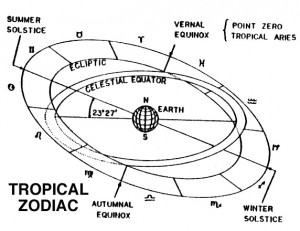
Freedom Cole’s ‘Tale of Two Zodiacs’ puts forward the premise that there are Two zodiacal Circles, one Stellar, the Nirayana system, and the other, a Seasonal or Tropical zodiac. According to Cole these two systems coexisted from ancient times but around the 10th or 11th century use of the Tropical system was suspended in favor of the Sidereal or Nirayana zodiac, considered to be superior because its movements were observable, historically relevant and astronomically measurable. It was, said the Nirayanis what astronomers actually saw when they looked at the heavens. The fixed Tropical system with its solstices and equinoxes was now considered by its critics to be an abstract or symbolic zodiac and no longer relevant. And while it had been shoved aside, proponents of each of these zodiacal systems continued to debate as to the point at which the true zodiacal circle actually begins; does it begin with the Spring Equinox as the Tropical system contends or does it begin at an arbitrary adjusted point based on stellar positions? According to Cole who describes himself as an ‘inclusivist’, he could argue for either side. But when he goes on to say that there is no right or best zodiac Cole gives credence to the erroneous conclusion that there are no absolute truths to be found in these matters; all zodiacal truths are simply relative. Of course when you go more deeply into the problem we discover that nothing could be farther from the truth.
While Cole writes authoritatively about the existence of two zodiacs, the Seasonal Tropical system and the Sidereal Nirayana zodiac he has in fact created a false premise. There is only One zodiac, just different starting points. The Tropical or Sayana system is Solar based and describes the orientation of the Earth to the Sun. It is based on the actual rhythms/seasons of the Earth and is balanced on the four Cardinal points (the Solstices and Equinoxes) which never change. There is thus no ambiguity in the starting point of the Sayana zodiac which is agreed upon by all Tropical astrologers.
The Sidereal or Nirayana system is based on the relationship between the Earth and the Stars (constellations). The Sidereal zodiac is Moveable as compared to the Fixed Tropical system. This is owing to a phenomenon known as the Precession of the Equinoxes whereby the spring equinoctial point is constantly moving backwards against the background of the fixed stars at the rate of about 50 arc seconds a year or 1 degree every 72 years. The Sidereal system seeks to compensate for this precessional movement by the calculation of an artificial starting point or ‘Ayanamsa’ a Sanskrit term that describes the increasing degrees of longitudinal difference between the fixed Tropical (Sâyana) zodiac of the seasons and the precessing Sidereal (Nirayana) zodiac of the constellations. Since there are more than 30 different Ayanamshas in use the starting point of the Sidereal zodiac is ambiguous and unreliable.
For example, suppose you are interested in having an astrological reading. If you give your date, time and place of birth to a Tropical astrologer anywhere in the world they will all come up with the exact same planetary positions. However, give the same birth information to a dozen Sidereal astrologers and they will come up with a dozen different planetary positions depending on the Ayanamsha that they use.
In the notes of Freedom Cole’s article he gives the dates of four different ayanamshas and their sources: 290 CE according to Lahiri Ayanâṁúâ (which is accepted by the Indian government), 359 CE according to Raman Ayanâṁúâ, 221 CE according to Fagan-Bradley, and 560CE according to De Luce. In just these four sources you will see a discrepancy in the amount of Precession of some 270 years. Given the rate of Precession of 1 degree for every 72 years there is a 3.75 degree discrepancy just between these four authorities. What Cole fails to mention is that there are not just four but over thirty popular Ayanamshas that differ from each other by a much wider degree. The lack of a reliable starting date for the Sidereal zodiac makes it virtually impossible for an astrologer to make accurate and consistent calculations for Transits and Progressions rendering the reading completely useless.
According to the present Sidereal system the Sun’s entrance into the sign Capricorn will occur on January 14th, some 23 day/degrees from the Tropical position of Capricorn which begins on the Winter Solstice, zero degree Capricorn, on December 22nd. According to Sidereal astrologers, anyone born from December 14th to January 14th will be a native of the sign Sagittarius which in Tropical measure includes the 30 day/degrees from November 22nd to December 22nd. In other words, Sidereal astrologers will classify 60% of all Capricorn natives under the wrong sign, and this same percentage of error will include the natives of all other astrological signs.
While the chaotic effect of the Sidereal Nirayana zodiac is self evident in matters of individual astrological calculation, it is far worse when applied to the calculations of the zodiacal ages which include time periods of thousands of years. An error of a few degrees can translate into hundreds of years which make an accurate calculation of the ages virtually impossible. According to the Lahiri Ayanâṁúâ, (officially recognized by the Indian government, the Age of Aquarius is expected to begin around 2364, some 350 years after the actual fact. What this means is that there will be no recognition of the Vishnu Avatars when they come and no understanding of the indispensable role they play for the civilization.The only way to remedy this appalling chaos and restore the true measure of the Cosmic Harmonies is by returning to the One Circle and Tropical zodiac used by the Vedic sages.
Robert E. Wilkinson (December 2015)
For more on this subject see: ‘The Importance of Makar Sankranti in Hindu Calendar Reform’ – a paper presented at the First National Conference on Hindu Calendar Reform, Tirumala, 24-26 December 2010.
